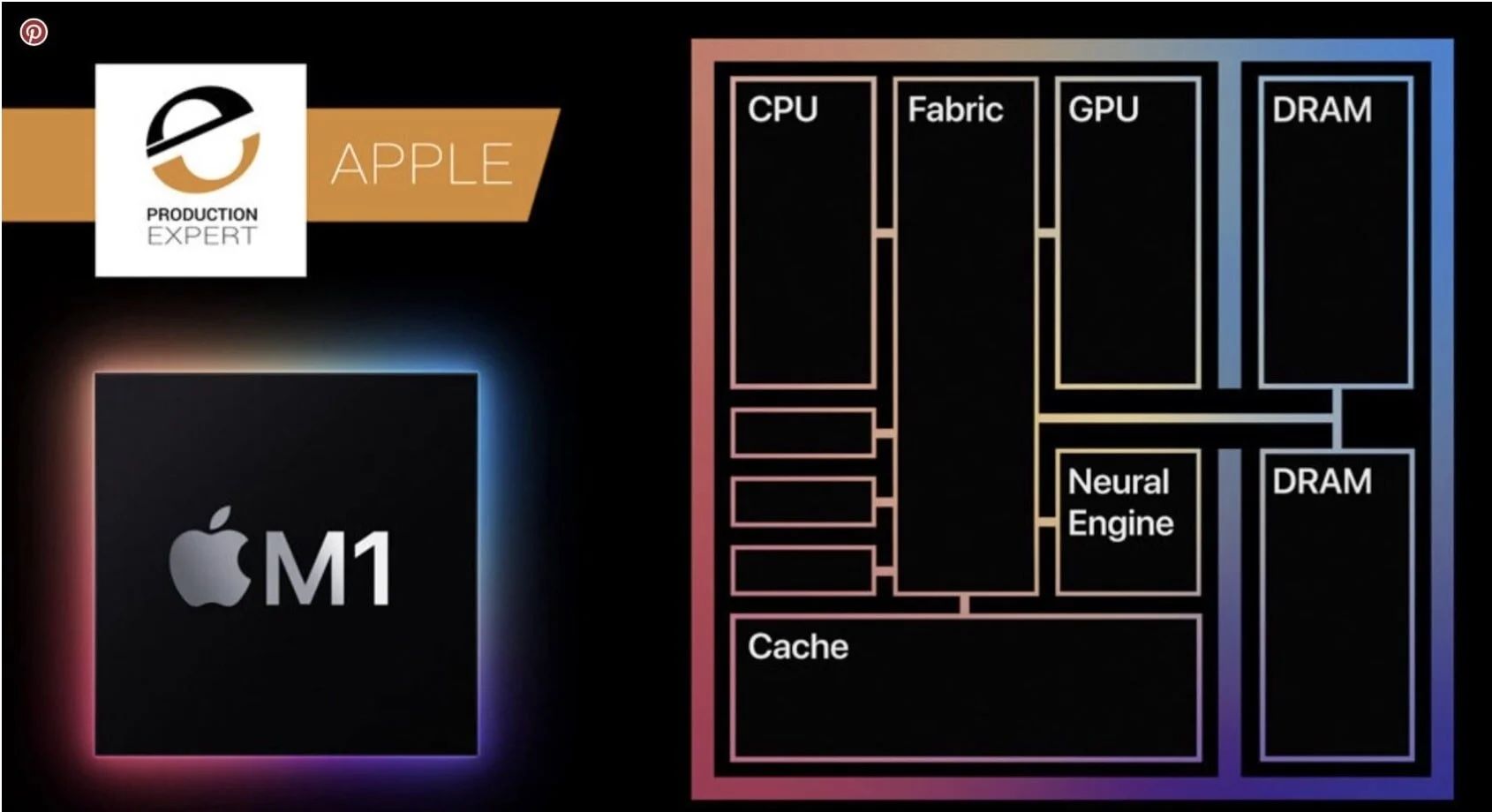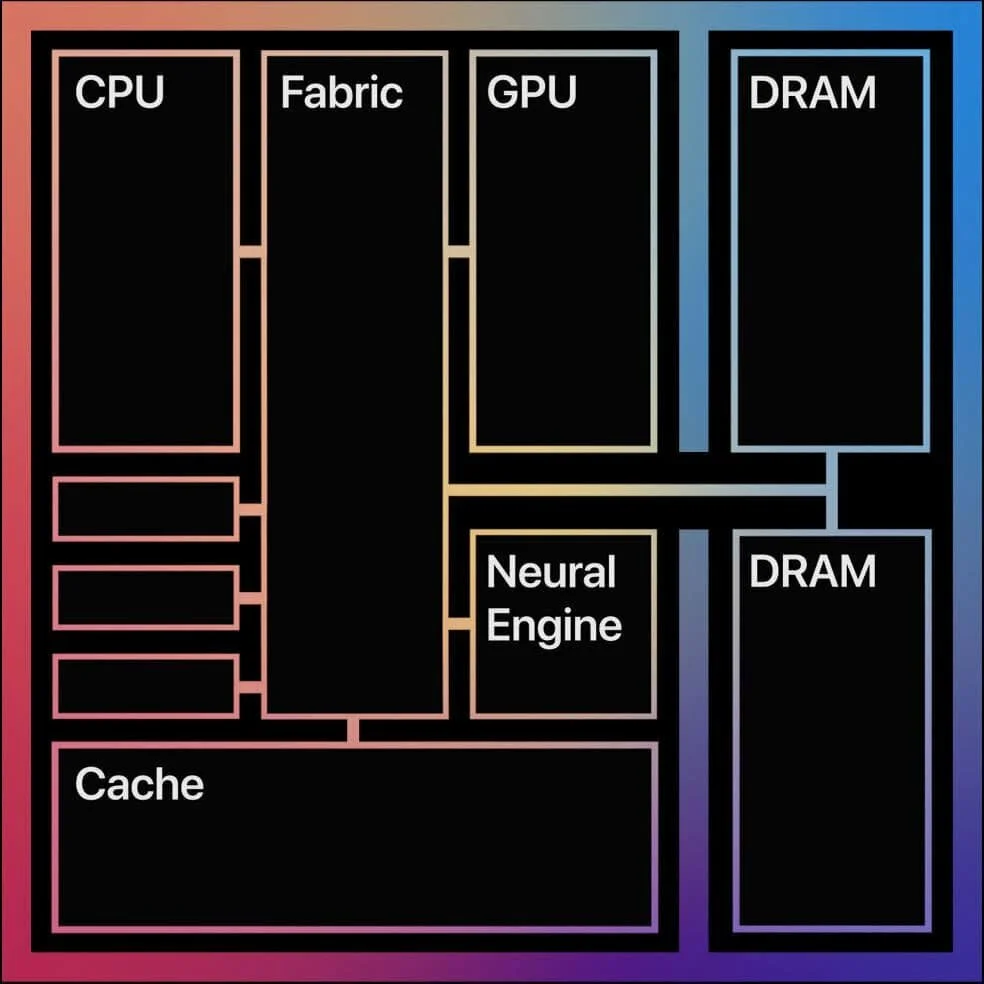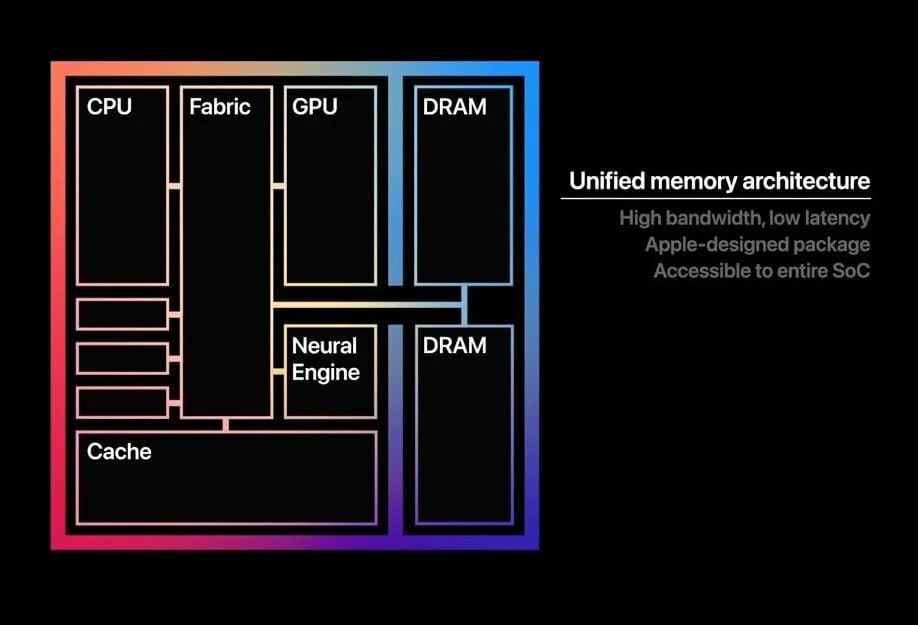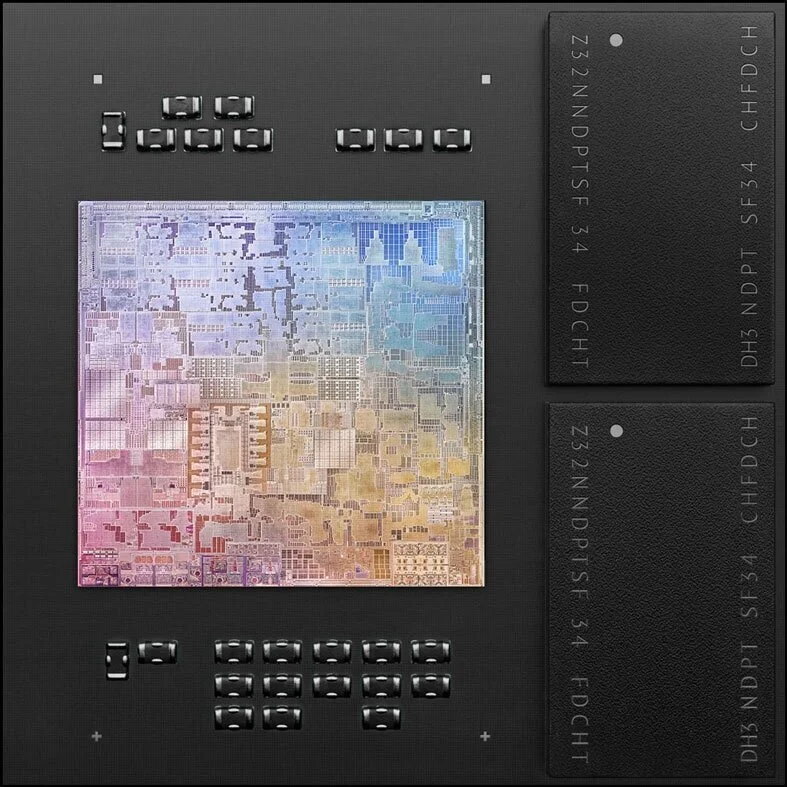
You may have wondered why the Apple M1 Chip is so fast? We have shown, with both the benchmark tests and our own more practical tests for Pro Tools, Logic and Studio One, even the first-generation Apple Silicon M1 powered Mac computers are remarkably fast. In this article, we learn from a developer as to what makes, even these entry-level Macs, so fast.
In his article, developer Erik Engheim has dug into what makes the M1 powered Macs so much faster than even some of their bigger Intel-powered brothers. Erik starts…
“On YouTube, I watched a Mac user who had bought an iMac last year. It was maxed out with 40 GB of RAM costing him about $4,000. He watched in disbelief how his hyper-expensive iMac was being demolished by his new M1 Mac Mini, which he had paid a measly $700 for.
In real-world test after test, the M1 Macs are not merely inching past top-of-the-line Intel Macs, they are destroying them. In disbelief, people have started asking how on earth this is possible?”

The M1 isn’t just a processor chip, its what is called a System-on-a-Chip or SoC for short. What that means is, that unlike computers to date, where the components that make up a computer are individual parts mounted on a motherboard, an SoC, like the Apple M1, brings together an 8-core CPU, 8-core GPU (7-core in some MacBook Air models), unified memory, SSD controller, image signal processor, Secure Enclave, on one chip.
Another reason the Apple Silicon chips perform so well is that as well as being together on one chip, the M1 is made up of a series of specialised tools. Erik explains…
Central processing unit (CPU) — the “brains” of the SoC. Runs most of the code of the operating system and your apps.
Graphics processing unit (GPU) — handles graphics-related tasks, such as visualizing an app’s user interface and 2D/3D gaming.
Image processing unit (ISP) — can be used to speed up common tasks done by image processing applications.
Digital signal processor (DSP) — handles more mathematically intensive functions than a CPU. Includes decompressing music files.
Neural processing unit (NPU) — used in high-end smartphones to accelerate machine learning (A.I.) tasks. These include voice recognition and camera processing.
Video encoder/decoder — handles the power-efficient conversion of video files and formats.
Secure Enclave — encryption, authentication, and security.
Unified memory — allows the CPU, GPU, and other cores to quickly exchange information.

Let’s dig into the last point, the on-chip memory. With the M1, this is also part of the SoC. The memory in the M1 is what is described as a ‘unified memory architecture’ (UMA) that allows the CPU, GPU, and other cores to exchange information between one another, and with unified memory, the CPU and GPU can access memory simultaneously rather than copying data between one area and another. Erik continues…
“For a long time, budget computer systems have had the CPU and GPU integrated into the same chip (same silicon die). In the past saying ‘integrated graphics’ was essentially the same as saying ‘slow graphics’. These were slow for several reasons:
Separate areas of this memory got reserved for the CPU and GPU. If the CPU had a chunk of data it wanted the GPU to use, it couldn’t say “here have some of my memory.” No, the CPU had to explicitly copy the whole chunk of data over the memory area controlled by the GPU.”
Another challenge is that CPUs and GPUs don’t want their memory served the same way. CPUs want their data served ‘little and often’. GPUs, however, want the complete opposite. They are happy to have infrequent huge portions of data. They can gobble huge amounts of data because they are parallel machines, that can chew through lots of data in simultaneously.
If like me, at this point you are thinking “so why has Apple put the CPU and GPU on the same chip?" Why doesn’t the M1 suffer the same problem as ‘computers with integrated graphics?” Stay with us, we will get there. Back to Erik…
“The second problem was that large GPUs produce a lot of heat and thus you cannot integrate them with the CPU without getting problems ridding yourself of the heat produced. Thus discrete graphics cards tend to [be large] beasts with massive cooling fans. They have special dedicated memory designed to serve the greedy cards massive amounts of data.
That is why these cards have high performance. But they have an achilles heel: Whenever they have to get data from the memory used by the CPU, this happens over a set of copper traces on the computer motherboard called a PCIe bus. Try chugging water through a super thin straw. It may get to your mouth fast, but the throughput is totally inadequate.”

Apple’s Unified Memory Architecture aims to solve these problems without the restrictions of ‘old school shared memory’ in 3 ways…
There is no special area reserved just for the CPU or just the GPU. Memory is allocated to both processors. They can both use the same memory. This means that no copying is needed and so things go faster.
Apple uses memory, which is designed to serve both large chunks of data and do it very quickly. It is called ‘low latency and high throughput’. This removes the need to have two different types of memory and all the copying of data between them, making the M1 faster.
With their iPhone and iPad design experience, Apple has been able to get the GPU power consumption down so that a relatively powerful GPU can be integrated into an SoC without overheating.
The takeaway here is that accessing the same pool of memory without the need for copying speeds up information exchange for faster overall performance.

Another benefit of a system-in-a-chip design is that everything so much closer together. At the speeds we are talking about, the distance data has to travel, even at the speed of light, can matter. It is going to be quicker to move data over millimetres or even microns within an SoC as opposed to centimetres around a motherboard.
Finally, the M1 does use virtual memory. VM is where the CPU uses hard disk space as RAM when it runs out of proper RAM. When we were using spinning rust drives that was so slow, hence the push to have as much RAM as you could afford. Now with NVMe drives you have hard drives that are pretty well as fast as RAM, so in an M1 system, although the virtual memory use is significant, it can be considered as fast as RAM in Intel machines.
Taken together, these benefits are what people like us are experiencing, as Erik says…
“This is part of the reason why a lot of people working on images and video editing with the M1 Macs are seeing such speed improvements. A lot of the tasks they do can run directly on specialized hardware. That is what allows a cheap M1 Mac Mini to encode a large video file, without breaking a sweat while an expensive iMac has all its fans going full blast and still cannot keep up.”
Now to be fair, specialised chips are nothing new but as Erik says, Apple is taking this concept and then taking a "more radical shift towards this direction."
Apple has been able to take their 10 years of experience developing phones and tablets that have become ever faster and more powerful, whilst becoming more power-efficient, which is crucial in portable devices where battery life is so important and where heat means power inefficiency.
Greg Joswiak, Apple’s senior vice president of worldwide marketing, has spoken about how Steve Jobs used to push Apple to “make the whole widget.”
“Steve used to say that we make the whole widget,” Joswiak told me. “We’ve been making the whole widget for all of our products, from the iPhone, to the iPads, to the watch. This was the final element to making the whole widget on the Mac.”
Developer Erik Engheim picks up on this point…
“Sure Intel and AMD may simply begin to sell whole finished SoCs. But what are these to contain? PC makers may have different ideas of what they should contain. You potentially get a conflict between Intel, AMD, Microsoft and PC makers about what sort of specialized chips should be included because these will need software support.”
The reality is that there are benefits that Intel and AMD will never be able to offer, even if they are dragged screaming and kicking into the SoC world, whereas Apple is able to offer the full deal because they control both the hardware and software.
“They give you, for example, the Core ML library for developers to write machine learning stuff. Whether Core ML runs on Apple’s CPU or the Neural Engine is an implementation detail developers don’t have to care about.”
Johny Srouj, senior vice president of hardware technologies at Apple, said in an interview with Om Malik that bringing the Mac processors in-house gives Apple far more control over the future:
“I believe the Apple model is unique and the best model,” he said. “We’re developing a custom silicon that is perfectly fit for the product and how the software will use it. When we design our chips, which are like three or four years ahead of time, Craig and I are sitting in the same room defining what we want to deliver, and then we work hand in hand. You cannot do this as an Intel or AMD or anyone else.”
Craig Federighi, Apple’s senior vice president of software engineering, echoed those thoughts:
“Being in a position for us to define together the right chip to build the computer we want to build and then build that exact chip at scale is a profound thing,” Federighi said about the symbiotic relationship between hardware and software groups at Apple. Both teams strive to look three years into the future and see what the systems of tomorrow look like. Then they build software and hardware for that future.
Coming back to the processors, another reason why the M1 is so fast is that Apple is using a processor design that is able to execute more instructions in parallel through what is called ‘Out-of-Order execution’, RISC architecture, and some specific tweaks Apple has used, which Erik provides an in-depth explanation of in his article. If you want to learn more then we do recommend you check out his article.

Then Apple Released The M1 Pro and M1 Max
In October 2021 Apple revealed details of the next instalment of the Apple Silicon transition. The M1 Pro and the M1 Max
The First Pro Chip Designed For The Mac - The M1 Pro
With the new Apple Silicon M1 Pro, the CPU part is the same on both chips, with a 10-core processor made up of eight high-performance cores and two energy-efficient cores. The difference is in the GPU part of the SoC. The new 2nd-gen chip has 16 graphics cores. This compares to 8 CPU cores, four high-performance cores and four energy-efficient cores and only 8 graphics cores with 32GB of RAM.
It can support up to 2 external displays as well as the built in screen.
The Second Pro Chip Designed For The Mac - The M1 Max
The second chip is the M1 Max, the CPU part is the same on both chips, with a 10-core processor made up of eight high-performance cores and two energy-efficient cores. The difference is in the GPU part of the SoC. The new 2nd-gen chip has 32 graphics cores. This compares to 8 CPU cores, four high-performance cores and four energy-efficient cores and only 8 graphics cores with 64GB of RAM.
The M1 Max has 7x faster than PC integrated graphics at same power. Similar performance to discrete graphics but with 70% less power. It can support up to 4 external displays as well as the built in screen.
Comparing to fastest PC laptop Apple could find, the M1 Max uses 100W less power with similar performance with Machine Learning tasks between 3 and 20 times faster than before.
Testing The M1 Max
As soon as we had access to one we tested the M1 Max with Pro Tools. There are lots of caveats around a test like this as the compatibility situation is complicated but even with these considerations the test results were stellar.
Instead of just recording 16 tracks at a low buffer setting we decided to really tax the new MacBook Pro with a large session to see what would happen. The session has over 700 tracks, with instances of the Xpand virtual instrument. The session also uses numerous instances of Avid stock plugins including 14 instances of EQIII, 117 instances of Dyn 3, 1113 instances of Channel Strip, 1 instance of Dverb and 1 instance of Dither.
To find out the details of this test follow this link to the test article.
This Is Fast But The Best Is Yet To Come
There you have it. Hopefully, we have been able to explain in an accessible way, why the Apple M1 powered entry-level first-generation Apple Silicon Macs are so quick and can do it with a relatively small amount of RAM. The M1 Pro and M1 Max offer a big performance bump bit it is clear that this isn’t the end of the story. Rumors of an Apple Silicon iMac seem more certain and our collective mids boggle at what an apple silicon Mac Pro might offer. Watch this space…
Featured
Apple M3 MacBook Air Announced
Predictions for New Apple Mac Computers And More In 2024
Apple Silicon: A Guide To Choosing The Right Mac For Your Studio
Audio Production Things We Loved In October 2023